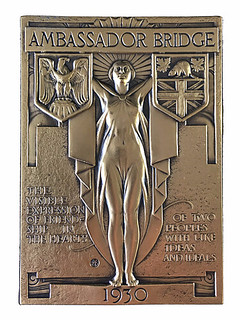
PREV ARTICLE
NEXT ARTICLE
FULL ISSUE
PREV FULL ISSUE
VOCABULARY TERM: PLAQUETTEI came across this entry from Dick Johnson's Encyclopedia of Coin and Medal Terminology. Although we've published it before (April, 2017), it's worth revisiting. -Editor
Unlike plaques, which are always uniface and larger than eight inches, plaquettes occasionally have a reverse design, particularly those that are diestruck since they are struck with two dies. Otherwise plaquettes have been made by every method that can reproduce a bas-relief design: many forms of casting, electroforming, repoussé, niello, and forging. But the casting technique, most often used in making early plaquettes, is in continuous use to the present. By making a negative wax impression from a model, pattern, or even an existing plaquette, it could then be cast in the positive. This would usually be cast in bronze. Infrequently, however, plaquettes were made in silver or lead – and much later – in iron, white metals, aluminum, and in the Orient, in pot metal. After casting, the items were often chased, casting imperfections removed and detail sharpened, termed cast and chased. Most relief items were given a patina, or, infrequently they were gilded or silverplated. The makers were the same artists that made medals, undoubtedly because of their experience working in bas-relief and casting in bronze. For collectors and curators it is necessary to determine the state of the casting, whether a plaquette is a contemporary cast, or a second or subsequent generation. Like cast Renaissance medals, a plaquette must be accurately measured to determine this state (see shrinkage). In modern times the relationship between plaquette and plaque is more than incidental. Plaquettes have, in fact, been reduced from the same model used for a plaque. A dieshell is made from the model or pattern which is then pantographically reduced to cut the plaquette die; meanwhile that exact same pattern can then be used to make the plaque the exact size by bronze casting. Often the plaquettes are distributed at the time of the dedication of the plaque after it has been installed. Mounting plaquettes. Uniface plaquettes were sometimes intended to be mounted on another surface. Because of their size they could be mounted on furniture, desk boxes, book covers, bases of small statues, other objects where an intimate decoration was required. Or, if not intended to be mounted on a flat surface, plaquettes would be provided with a support on the back to be able to stand upright on a table, mantel, altar or shelf. The pax of the Catholic Church, intended to stand upon the altar, is an example of a plaquette with such a support. The back of a plaquette was usually left untreated, particularly if intended to be mounted. But just as often it was finished, or a backplate was attached. History of plaquettes. Early plaquettes were reproduced and this art form spread from their birthplace in Italy – exactly like Renaissance medals – across the Alps to Germany, France, the Low countries and the rest of Europe. Plaquettes may have, indeed, predated the art medal. Some cast pieces in the 12th and 13th century in square or rectangular shape could meet the above definition and be considered plaquettes (particularly those mounted on the bases of statues). When Pisanello created an entirely new art form in 1439 by casting the first art medal in lost wax, he also set the stage for the development of the plaquette as a separate object made by the same technique. Thus the plaquette closely paralleled the development of the art medal. Certainly the artistic treatment and strongly religious themes were similar for both classes of art objects. References:
NC5 {1951} National Gallery of Art (Kress collection).
Looking for the meaning of a numismatic word, or the description of a term? Try the Newman Numismatic Portal's Numismatic Dictionary at: https://nnp.wustl.edu/library/dictionary
Or if you would like a printed copy of the complete Encyclopedia, it is available.
There are 1,854 terms, on 678 pages, in The Encyclopedia of Coin and Medal Technology. Even running two a week would require more than 19 years to publish them all.
If you would like an advance draft of this vital reference work it may be obtained from the author for your check of $50 sent postpaid. Dick Johnson, 139 Thompson Drive, Torrington, CT 06790.
The Numismatic Bibliomania Society is a non-profit organization promoting numismatic literature. See our web site at coinbooks.org. To submit items for publication in The E-Sylum, write to the Editor at this address: whomren@gmail.com To subscribe go to: https://my.binhost.com/lists/listinfo/esylum All Rights Reserved. NBS Home Page Contact the NBS webmaster 
|
